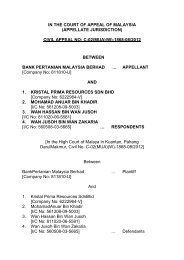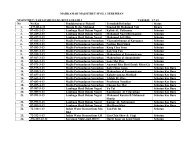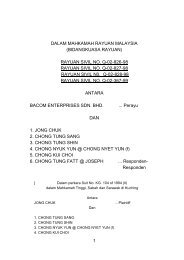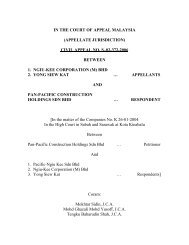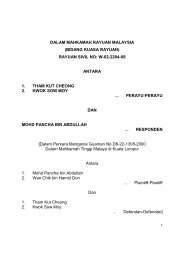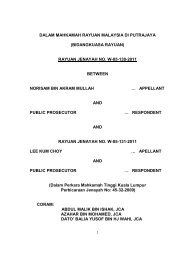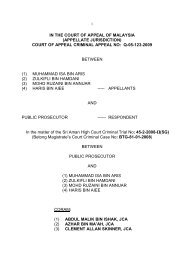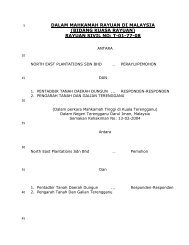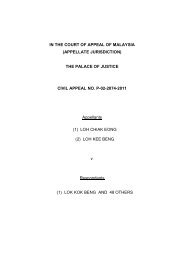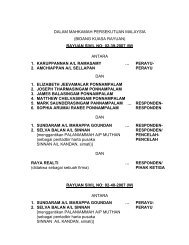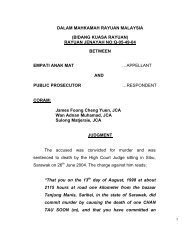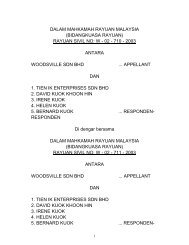rayuan jenayah no: c-05-146-2009 di antara azhar bin lazim
rayuan jenayah no: c-05-146-2009 di antara azhar bin lazim
rayuan jenayah no: c-05-146-2009 di antara azhar bin lazim
You also want an ePaper? Increase the reach of your titles
YUMPU automatically turns print PDFs into web optimized ePapers that Google loves.
1<br />
DALAM MAHKAMAH RAYUAN MALAYSIA<br />
(BIDANG KUASA RAYUAN)<br />
RAYUAN JENAYAH NO: C-<strong>05</strong>-<strong>146</strong>-<strong>2009</strong><br />
DI ANTARA<br />
AZHAR BIN LAZIM ------ PERAYU<br />
DAN<br />
PENDAKWA RAYA ------ RESPONDEN<br />
Dalam Perkara Mengenai Mahkamah Tinggi Temerloh<br />
Perbicaraan Jenayah No: 45-01-2006<br />
CORAM:<br />
DI ANTARA<br />
PENDAKWA RAYA<br />
DAN<br />
AZHAR BIN LAZIM<br />
(1) HASAN LAH, JCA<br />
(2) ABDUL MALIK BIN ISHAK, JCA<br />
(3) SYED AHMAD HELMY BIN SYED AHMAD, JCA
Introduction<br />
2<br />
ABDUL MALIK BIN ISHAK, JCA<br />
DELIVERING THE JUDGMENT OF THE COURT<br />
[1] The appellant was charged for trafficking in dangerous drugs, to<br />
wit, 3,917 grammes of cannabis, an offence under section 39B(1)(a) of the<br />
Dangerous Drugs Act 1952 (“DDA”) and punishable under section 39B(2)<br />
of the DDA. The charge against the appellant was worded in this way:<br />
“Bahawa kamu pada 18hb Februari 20<strong>05</strong> jam lebih kurang 9.30<br />
malam <strong>di</strong> kawasan Parking Pam Minyak BP, Jalan Tras, <strong>di</strong> dalam<br />
Daerah Raub, Negeri Pahang Darul Makmur, telah <strong>di</strong>dapati mengedar<br />
dadah berbahaya iaitu 5 ketulan mampat daun kering mengandungi<br />
3,917 gram cannabis tanpa kebenaran yang sah <strong>di</strong> sisi undangundang,<br />
oleh itu kamu telah melakukan suatu kesalahan <strong>di</strong> bawah<br />
seksyen 39B(1)(a) Akta Dadah Berbahaya 1952 dan boleh <strong>di</strong>hukum <strong>di</strong><br />
bawah seksyen 39B(2) Akta Dadah Berbahaya 1952.”<br />
[2] The appellant claimed trial and the prosecution called seven (7)<br />
witnesses. At the close of the prosecution’s case, the High Court found that<br />
a prima facie case was established and called the appellant to enter his<br />
defence. The appellant gave his evidence under oath and he too called his<br />
wife Norhayati <strong>bin</strong>ti Zakaria (SD2) as his witness. At the end of the defence<br />
case, the High Court found the appellant guilty of the charge and<br />
sentenced him to death. Aggrieved, the appellant <strong>no</strong>w appeals to this<br />
Court.
The prosecution’s case<br />
3<br />
[3] On 18.2.20<strong>05</strong>, the chief narcotics <strong>di</strong>vision of the Bentong police<br />
station by the name of ASP Roslee <strong>bin</strong> Jusoh (SP5) received an<br />
information that a Malay man would be trafficking in drugs using a Felda oil<br />
tanker lorry at the BP petrol station, at Jalan Tras, Raub, Pahang (“BP<br />
petrol station”). SP5 then assigned Detective Sergeant Redzuan Abdullah<br />
(SP6) to act as an agent provocateur by impersonating as a buyer to<br />
purchase the drugs.<br />
[4] SP5 assembled his police personnel together with SP6 and<br />
briefed them pertaining to the operation of laying an ambush and to arrest<br />
the suspect. SP6 was detailed to approach the suspect under the guise of<br />
purchasing the drugs. When SP6 has been shown the drugs by the<br />
suspect, SP6 would light a cigarette as a signal to the rai<strong>di</strong>ng party to swing<br />
into action and to effect the arrest on the suspect.<br />
[5] On 18.2.20<strong>05</strong>, at about 8.30 p.m., SP5 and his police party arrived<br />
at the BP petrol station and took up ambush positions. At about 9.00 p.m.,<br />
SP6 was seen alone driving a motor car and entering the BP petrol station<br />
area and waited for the suspect. At about 9.20 p.m., a Felda oil tanker lorry<br />
was seen entering the BP petrol station area and stopped at the designated<br />
parking bay. SP6 then drove his motor car forward towards the parked<br />
Felda oil tanker lorry from the rear. SP6 alighted from his motor car and
4<br />
met the driver of the Felda oil tanker lorry at the rear of the said lorry. SP6<br />
was seen talking and <strong>di</strong>scussing with the driver (identified as the appellant)<br />
and that Felda oil tanker lorry can be seen at photograph marked as exhibit<br />
“P5”.<br />
[6] SP6 asked the appellant “mana ganja?”. The appellant replied,<br />
“ada”. SP6 then enquired “berapa?”, and the appellant replied “5 kilo”.<br />
The appellant was then seen entering the front part of the said lorry and<br />
came down carrying a white plastic bag (exhibit “P3A”) with the word<br />
“Ocean” written on it and showed it to SP6. The appellant opened the<br />
white plastic bag and SP6 saw inside it a red<strong>di</strong>sh plastic containing five<br />
compressed dried leaves suspected to be cannabis. Having satisfied<br />
himself that the appellant was carrying the drugs, SP6 then told the<br />
appellant that he would take the money from his motor car and SP6 then<br />
walked away from the appellant. At this juncture, SP6 gave the pre-planned<br />
signal by lighting his cigarrete for the police party to swing into action.<br />
[7] On seeing the signal, SP5 and his police party rushed towards the<br />
appellant who by this time had walked towards the front part of the said<br />
lorry. On reaching the appellant, SP5 identified himself and arrested the<br />
appellant. Thereafter SP5 frantically searched for any incriminating articles<br />
outside and inside the Felda oil tanker lorry but to <strong>no</strong> avail. SP5 then read<br />
the caution under section 37A(1)(b) of the DDA to the appellant and SP5
5<br />
then asked the appellant “ada bawa apa-apa barang?” The appellant<br />
replied “ada bawa ganja 5 k”. SP5 then asked the appellant “<strong>di</strong> mana<br />
kamu sembunyi?”, and the appellant replied “saya sembunyi dalam<br />
rumput depan lori”. The appellant then in<strong>di</strong>cated to SP5 the <strong>di</strong>rection<br />
where the drugs were hidden by puckering his lips. SP5 followed the<br />
<strong>di</strong>rection and together with the appellant SP5 found a white plastic bag<br />
(exhibit “P3A”) on the grass in front of the said lorry with the word<br />
“Ocean” written on it and after SP5 examined it, in the presence of the<br />
appellant, SP5 found inside it a<strong>no</strong>ther red<strong>di</strong>sh plastic bag (exhibit “P3B”)<br />
containing five compressed dried leaves suspected to be cannabis (exhibits<br />
“P10”, “P12”, “P14”, “P16” and “P18”).<br />
[8] SP5 also placed under arrest a Malay lady who sat at the<br />
passenger’s side of the Felda oil tanker lorry and she was identified as the<br />
wife of the appellant who gave evidence in Court as the appellant’s witness<br />
(SD2).<br />
[9] The exhibits together with the appellant and SD2 were then taken<br />
to Ibu Pejabat Daerah (IPD) Raub where SP5 lodged a police report vide<br />
Raub report number 351/20<strong>05</strong>. A search list (exhibit “P19”) was also<br />
prepared and the exhibits were also marked accor<strong>di</strong>ngly. Photographs<br />
were also taken.
6<br />
[10] In due course, the government chemist analysed and confirmed<br />
that the five compressed dried leaves were cannabis, a dangerous drug<br />
under the DDA, weighing 3,917 grammes.<br />
The defence case<br />
[11] The learned High Court Judge was correct when his Lordship<br />
remarked that the appellant “gave a totally contra<strong>di</strong>ctory story of the<br />
whole incident”. His Lordship then reproduced verbatim the defence of<br />
the appellant and we are constrained to do so likewise. The appellant gave<br />
his evidence in the Malay language and it was in this fashion as seen at<br />
pages 117 to 118 of the appeal record (evidence by way of an examination-<br />
in-chief):<br />
“Masa itu 1 kereta datang parking <strong>di</strong> belakang lori saya.Kemu<strong>di</strong>an<br />
turun seorang lelaki Cina, <strong>di</strong>a menghampiri saya memanggil saya<br />
‘brother’, ‘brother’. Saya bangun dan tanya ‘kenapa’. Dia tanya ‘ada<br />
barang itu’? Saya tanya ‘barang apa’. Dia kata ganja. Saya kata saya<br />
tak ada barang itu. Saya kata ‘awak salah orang’. Dia kata ‘tak<br />
mungkin salah orang’. Saya kata ‘saya tak kenal awak’. Kemu<strong>di</strong>an ia<br />
keluar seikat duit. Dia tunjuk kepada saya sambil kata ‘kalau tak<br />
percaya ini duit’. Saya kata ‘minta maaf, saya tidak tahu apa-apa,<br />
saya tidak ada barang itu’.”<br />
[12] Continuing at pages 118 to 120 of the appeal record, the<br />
appellant testified in examination-in-chief in this way:<br />
“Masa itu datang seorang lelaki dari arah lori kecil. Dia panggil saya<br />
‘Bang’. Dia menghampiri saya. Bila <strong>di</strong>a dekat ia peluk saya dari<br />
belakang dan tarik tangan saya ke belakang dan terus <strong>di</strong>gari. Saya<br />
bertanya ‘kenapa ni’, ‘apa hal’. Dia tak jawab apa-apa. Saya<br />
perhatikan <strong>di</strong> hadapan lori ada 3-4 orang datang juga dari arah<br />
belakang. Mereka membawa saya ke depan lori. Salah seorang soal<br />
saya ‘mana barang itu’, saya kata saya tak tahu barang apa. Lepas
7<br />
itu salah seorang memukul perut saya. Kemu<strong>di</strong>an <strong>di</strong>ikuti pukul <strong>di</strong><br />
muka dan perut sehingga saya terduduk melutut. Kemu<strong>di</strong>an salah<br />
seorang membangunkan saya dan salah seorang pegang dagu saya,<br />
kemu<strong>di</strong>an menampar muka saya. Ia memberi amaran ‘dengar sini’,<br />
apa-apa percakapan daripada awak akan menja<strong>di</strong> bukti’. Sekali lagi<br />
saya <strong>di</strong>tampar. Dia tanya ‘mana barang itu’. Saya jawab ‘tak tahu’,<br />
tolonglah saya tak tahu apa-apa’. Kemu<strong>di</strong>an saya <strong>di</strong>pukul <strong>di</strong> perut<br />
saya terduduk lagi melutut <strong>di</strong>ikuti dengan beberapa pukulan hingga<br />
saya rebah. Masa itu saya dengar rungutan ‘Oo kau degil lagi’. Terus<br />
saya <strong>di</strong>sepak <strong>di</strong> perut. Oleh kerana saya tak tahan saya menjerit dan<br />
saya berkata, ‘Ok-Ok nanti dulu’. Saya <strong>di</strong>bangunkan semula. Salah<br />
seorang kata ‘ha.. kan senang’. Kemu<strong>di</strong>an saya <strong>di</strong>papah ke kelapa<br />
sawit <strong>di</strong> hadapan lori. Kemu<strong>di</strong>an saya <strong>di</strong>dudukkan secara melutut. Di<br />
depan saya terdapat 1 beg plastik berwarna putih.”<br />
[13] In his defence, the appellant testified that he was approached,<br />
while he was stan<strong>di</strong>ng behind the Felda oil tanker lorry which was parked at<br />
the BP petrol station, by a male Chinese who initially asked about the<br />
“barang” and when asked what was the “barang” by the appellant, that<br />
male Chinese was referring to “ganja”. The appellant retorted that he <strong>di</strong>d<br />
<strong>no</strong>t have that “barang” and that the male Chinese might be referring to<br />
someone else. But the male Chinese insisted that the appellant was the<br />
right person. Again, the appellant denied and at this point of time, the male<br />
Chinese produced some money and showed it to the appellant. The<br />
appellant apologised and told the male Chinese that he <strong>di</strong>d <strong>no</strong>t have that<br />
“barang”.<br />
[14] The appellant further testified that he was assaulted by the police<br />
personnel at the scene of the crime that caused him to show the location of<br />
the drugs. This allegation by the appellant that he was assaulted by the
8<br />
police personnel when he was arrested that caused him to show the<br />
location of the drugs within the grass near to the front of the Felda oil<br />
tanker lorry which was parked at the BP petrol station was raised for the<br />
very first time in his defence.<br />
[15] SD2 – the appellant’s wife, testified along the following lines.<br />
That she accompanied the appellant in the Felda oil tanker lorry from Port<br />
Klang to Raub and there they stopped at the BP petrol station. She alighted<br />
from the Felda oil tanker lorry to ease herself at the toilet. She testified that<br />
she went to the toilet between five to six minutes and when she returned,<br />
the appellant was still seated behind the steering wheel of the Felda oil<br />
tanker lorry. As soon as she re-entered the said lorry, the appellant<br />
alighted. She remained seated in the Felda oil tanker lorry.<br />
[16] Accor<strong>di</strong>ng to SD2, she witnessed her husband being arrested<br />
outside the Felda oil tanker lorry more to the front. There were about five to<br />
six people that raided the said lorry. After the appellant was arrested, she<br />
was asked to alight from the said lorry by the police. She complied and she<br />
was taken to a motor car which was quite a <strong>di</strong>stance away from the said<br />
lorry.<br />
[17] Accor<strong>di</strong>ng to SD2, she was <strong>no</strong>t sure as to what had transpired<br />
between the police and her husband – the appellant.
9<br />
[18] Accor<strong>di</strong>ng to SD2, the police told her that her husband was<br />
arrested for trafficking drugs. She said that she <strong>di</strong>d <strong>no</strong>t see her husband<br />
carrying any package from Port Klang.<br />
[19] Under cross-examination, she testified that she would <strong>no</strong>t k<strong>no</strong>w<br />
whether her husband alighted from the said lorry when she was in the<br />
toilet.<br />
Analysis<br />
[20] Independent of any presumption, this is a case where sufficient<br />
evidence was led by the prosecution wherein a strong inference may be<br />
drawn that the appellant had k<strong>no</strong>wledge of the drugs and that it was in his<br />
exclusive physical possession. From the evidence adduced, an irresistible<br />
inference may be inferred that the appellant was aware of his possession<br />
and that he knew the nature of the drug which he possessed and he too<br />
had the necessary power of <strong>di</strong>sposal over it. To put it succinctly, the<br />
appellant had mens rea possession.<br />
[21] It is essentially a question of law as to what constitutes<br />
possession. And whether the appellant was in possession of the drug, is<br />
purely a question of fact (Pendakwa Raya v Kang Ho Soh [1992] 1 MLJ<br />
360, at page 371). The facts must be scrutinised and analysed in order to<br />
establish possession. K<strong>no</strong>wledge is one of the essential ingre<strong>di</strong>ents of<br />
possession. It reflects the mental element (Public Prosecutor v.
10<br />
Badrulsham <strong>bin</strong> Baharom [1988] 2 MLJ 585). Accor<strong>di</strong>ng to Sharma J in<br />
Yee Ya Mang v. Public Prosecutor [1972] 1 MLJ 120, the word<br />
“possession” is defined in this way:<br />
“The word ‘possession’ implies a physical capacity to deal with the<br />
thing as one likes to the exclusion of everyone and a determination<br />
to exercise that physical power on one’s own behalf. It implies<br />
dominion and consciousness in the mind of the person having<br />
‘possession’ that he <strong>no</strong>t only has such dominion but also that he can<br />
exercise it.”<br />
[22] The prosecution can easily prove possession in two ways. By<br />
<strong>di</strong>rect or circumstantial evidence. Under the DDA, possession can also be<br />
proven by invoking the statutory presumption under section 37(d) provided<br />
custody or control of anything whatsoever containing any dangerous drug<br />
is proven. But in the context of the present appeal, the High Court found<br />
that there was <strong>no</strong> necessity to resort to the presumption of possession<br />
under the DDA. This was what the High Court said at page 20 of the appeal<br />
record:<br />
“Looking in totality the evidence of SP5 and SP6 there is ample<br />
<strong>di</strong>rect evidence to show that the accused had complete and<br />
exclusive possession of the drugs found. This is a case where the<br />
prosecution need <strong>no</strong>t resort to the presumption of possession<br />
available under the DDA.”<br />
[23] The evidence of the two prosecution witnessess – SP5 and SP6,<br />
established beyond reasonable doubt that the appellant had possession of<br />
the dangerous drugs in question. At pages 14 to 15 of the appeal record,<br />
this was what the High Court said:
11<br />
“It was SP5’s evidence that he saw SP6 talking with the accused and<br />
the accused then going to the front of the tanker and bringing back a<br />
white plastic which he identified as the plastic bearing the words<br />
‘Ocean’ which was recovered later at the front of the tanker. Further<br />
after the accused was arrested and when questioned by SP5<br />
admitted having the drugs with him and then showed SP5 where the<br />
plastic bag containing the drugs was.”<br />
[24] Now, accor<strong>di</strong>ng to SP6, he approached the appellant and<br />
inquired as to whether the appellant had the drugs. The appellant<br />
answered “yes”. A short while later, the appellant showed a white plastic<br />
bag to SP6 with the writing “Ocean” on it. Accor<strong>di</strong>ng to SP6, the appellant<br />
opened the white plastic bag and showed its contents suspected to be<br />
drugs to SP6. After seeing the contents and on the pretext of taking the<br />
money at his motor car in order to effect payment, SP6 proceeded towards<br />
his motor car and at the same time lighted a cigarette as a signal for the<br />
police party to ambush the appellant.<br />
[25] In our judgment, the High Court was right when it convicted the<br />
appellant for trafficking in the dangerous drugs as per the charge. There<br />
was more than ample evidence adduced by the prosecution witnesses SP5<br />
and SP6 which showed that the appellant had possession and k<strong>no</strong>wledge<br />
of the dangerous drugs in question and that the burden was on the<br />
appellant to create a reasonable doubt in the prosecution’s case<br />
(Mohamad Radhi <strong>bin</strong> Yaakob v Public Prosecutor [1991] 3 MLJ 169,<br />
SC; and Mat v. Public Prosecutor [1963] 29 MLJ 263).
12<br />
[26] The appellant, in his defence, denied that he was in possession<br />
of ganja (cannabis) that was found on the grass in front of the Felda oil<br />
tanker lorry. The appellant testified that he stopped at the BP petrol station<br />
because his wife wanted to use the toilet and <strong>no</strong>t because he wanted to<br />
transact the sale of the drugs. The appellant also denied that at the time of<br />
his arrest he was <strong>no</strong>t in the process of han<strong>di</strong>ng over the drugs to SP6 but<br />
rather he was examining the said lorry.<br />
[27] A cre<strong>di</strong>ble defence is a defence that answers the evidence of<br />
the prosecution. It is purely a question of fact whether the explanation of<br />
the defence is capable of raising a reasonable doubt. All too often, and the<br />
present appeal is <strong>no</strong>t an exception, the accused is condemned by his own<br />
conduct (Public Prosecutor v Reza Mohd Shah <strong>bin</strong> Ahmad Shah [2002]<br />
4 MLJ 13; Krishna Rao Gurumurthi v. PP and a<strong>no</strong>ther appeal [<strong>2009</strong>] 2<br />
CLJ 603, FC; Amathevelli P Ramasamy v. PP [<strong>2009</strong>] 3 CLJ 109, FC;<br />
and Pendakwa Raya v Lim Hock Boon [<strong>2009</strong>] 2 AMR 768, FC). It is<br />
necessary for the accused to explain his conduct.<br />
[28] In Amathevelli P Ramasamy v. PP (supra), the conviction of<br />
the appellant was affirmed by the Federal Court on the sole ground of her<br />
subsequent conduct which consisted of the following acts:
13<br />
(a) bringing the police team to her house;<br />
(b) using the key attached to the chain that she was wearing to open<br />
the cupboard;<br />
(c) taking out a folded green blouse from the cupboard; and<br />
(d) taking out from the blouse a folded handkerchief containing<br />
exhibits “P40” and “P44 A-F” which belonged to the deceased.<br />
[29] The appellant testified that he was assaulted by the police at the<br />
time of his arrest, yet he <strong>di</strong>d <strong>no</strong>t lodge a police report or complain to the<br />
Magistrate when he was remanded. In actual fact the allegation of being<br />
assaulted was <strong>no</strong>t put across to the prosecution witnesses and it was<br />
raised for the first time in his defence (Tan Kim Ho & A<strong>no</strong>r v. PP [<strong>2009</strong>] 3<br />
CLJ 236, FC; Aik Ming (M) Sdn Bhd & 8 Ors v Chang Ching Chuen & 3<br />
Ors & A<strong>no</strong>ther Case [1995] 3 CLJ 639, CA; Chua Beow Huat v Public<br />
Prosecutor [1970] 2 MLJ 29; AEG Carapiet v. AY Derderian AIR [1961]<br />
Calcutta 359; Wong Swee Chin v Public Prosecutor [1981] 1 MLJ 212,<br />
FC; and Public Prosecutor v Lin Lian Chen [1992] 2 MLJ 561, SC). The<br />
whole purpose of the defence having to put its case to the prosecution<br />
witnesses is for the prosecution to check on whether the appellant’s<br />
version of the facts is true or false. It is also for the purpose of avoi<strong>di</strong>ng an<br />
adverse comment by the prosecution, like the present appeal at hand, that<br />
such a defence is a recent invention. But such failure on the part of the
14<br />
defence to put its case across can never, stan<strong>di</strong>ng by itself, relieve the<br />
prosecution of its duty of establishing the charge of trafficking in the<br />
dangerous drugs, to wit, 3,917 grammes of cannabis as per the charge<br />
beyond any reasonable doubt (Alcontara a/l Ambross Anthony v. Public<br />
Prosecutor [1996] 1 CLJ 7<strong>05</strong>, FC).<br />
[30] Seen in its correct perspective, the evidence of SP5 and SP6 are<br />
cre<strong>di</strong>ble. There were mi<strong>no</strong>r <strong>di</strong>screpancies in their evidence. But generally<br />
they support one a<strong>no</strong>ther and it was in the nature of a <strong>di</strong>rect evidence<br />
showing that the appellant had exclusive possession and was trafficking in<br />
the dangerous drugs in question.<br />
[31] As police officers both SP5 and SP6 were carrying out their<br />
duties in accordance with the law and there was <strong>no</strong> reason for them to lie.<br />
In Public Prosecutor v. Mohamed Ali [1962] 28 MLJ 257, Thomson CJ<br />
had this to say about the evidence of a police witness (see page 258 of the<br />
report):<br />
“When a Police witness says something that is <strong>no</strong>t inherently<br />
improbable his evidence must in the first instance be accepted.”<br />
[32] Continuing at the same page, this was what his Lordship said:<br />
“In the absence of contra<strong>di</strong>ction, however, and in the absence of any<br />
element of inherent improbability the evidence of any witness,<br />
whether a Police witness or <strong>no</strong>t, who gives evidence on affirmation,<br />
should <strong>no</strong>rmally be accepted.”
15<br />
[33] In Chean Siong Guat v. Public Prosecutor [1969] 2 MLJ 63,<br />
Abdul Hamid Omar J (later the Lord President of the Supreme Court), had<br />
this to say about <strong>di</strong>screpancies:<br />
“Discrepancies may, in my view, be found in any case for the simple<br />
reason that <strong>no</strong> two persons can describe the same thing in exactly<br />
the same way. Sometimes what may appear to be <strong>di</strong>screpancies are<br />
in reality <strong>di</strong>fferent ways of descri<strong>bin</strong>g the same thing, or it may<br />
happen that the witnesses who are descri<strong>bin</strong>g the same thing might<br />
have seen it in <strong>di</strong>fferent ways and at <strong>di</strong>fferent times and that is how<br />
<strong>di</strong>screpancies are likely to arise.”<br />
[34] Charles Ho J., in Mohamed Alias v. Public Prosecutor [1983]<br />
2 MLJ 172, at page 173, considered <strong>di</strong>screpancies in this way:<br />
“In considering the <strong>di</strong>screpancies the court should take into account<br />
the educational background and experience of the witness and<br />
whether the witness is descri<strong>bin</strong>g events which have taken place<br />
recently or a long time ago and the demea<strong>no</strong>ur.”<br />
[35] Raja Azlan Shah FJ (as His Majesty then was) in Public<br />
Prosecutor v. Datuk Haji Harun <strong>bin</strong> Haji Idris (No. 2) [1977] 1 MLJ 15,<br />
at page 19 aptly said:<br />
“In my opinion <strong>di</strong>screpancies there will always be, because in the<br />
circumstances in which the events happened, every witness does<br />
<strong>no</strong>t remember the same thing and he does <strong>no</strong>t remember accurately<br />
every single thing that happened.”<br />
[36] And continuing at the same page, His Majesty had this to say:<br />
“I shall be almost inclined to think that if there are <strong>no</strong> <strong>di</strong>screpancies,<br />
it might be suggested that they have concocted their accounts of<br />
what had happened or what had been said because their versions<br />
are too consistent. The question is whether the existence of certain<br />
<strong>di</strong>screpancies is sufficient to destroy their cre<strong>di</strong>bility. There is <strong>no</strong><br />
rule of law that the testimony of a witness must either be believed in
16<br />
its entirety or <strong>no</strong>t at all. A court is fully competent, for good and<br />
cogent reasons, to accept one part of the testimony of a witness and<br />
to reject the other. It is, therefore, necessary to scrutinize each<br />
evidence very carefully as this involves the question of weight to be<br />
given to certain evidence in particular circumstances.”<br />
[37] In the present appeal, the High Court preferred the evidence of<br />
SP5 and SP6 as opposed to the evidence of the appellant. At page 18 of<br />
the appeal record, this was what the High Court said:<br />
“Besides that in comparing the evidence of SP5 and SP6 against that<br />
of the accused I chose to believe the evidence of the prosecution<br />
witnesses as their evidence was spontaneous and consistent as<br />
compared (to) the accused, who was hesitant in answering certain<br />
questions.”<br />
[38] Now, the information by the appellant to SP5 was clear. It led to<br />
the recovery of the drugs on the grass in front of the said lorry. Section 27<br />
of the Evidence Act 1950 enacts as follows:<br />
“When any fact is deposed to as <strong>di</strong>scovered in consequence of<br />
information received from a person accused of any offence in the<br />
custody of a police officer, so much of that information, whether the<br />
information amounts to a confession or <strong>no</strong>t, as relates <strong>di</strong>stinctly to<br />
the fact thereby <strong>di</strong>scovered may be proved.”<br />
[39] The rationale of section 27 of the Evidence Act 1950 is quite<br />
simple. If the information by the accused is supported by the <strong>di</strong>scovery of a<br />
certain fact, that information may be presumed to be true and that<br />
information can<strong>no</strong>t be construed to have been extracted. Accor<strong>di</strong>ng to Sir<br />
John Beaumont in the Privy Council case of Pulukuri Kottaya and others<br />
v. Emperor AIR [1947] PC 67, 70:
17<br />
“Section 27, which is <strong>no</strong>t artistically worded, provides an exception<br />
to the prohibition imposed by the prece<strong>di</strong>ng section, and enables<br />
certain statements made by a person in police custody to be proved.<br />
The con<strong>di</strong>tion necessary to bring the section into operation is that<br />
<strong>di</strong>scovery of a fact in consequence of information received from a<br />
person accused of any offence in the custody of a Police officer<br />
must be deposed to, and thereupon so much of the information as<br />
relates <strong>di</strong>stinctly to the fact thereby <strong>di</strong>scovered may be proved. The<br />
section seems to be based on the view that if a fact is actually<br />
<strong>di</strong>scovered in consequence of information given, some guarantee is<br />
afforded thereby that the information was true, and accor<strong>di</strong>ngly can<br />
be safely allowed to be given in evidence; but clearly the extent of<br />
the information admissible must depend on the exact nature of the<br />
fact <strong>di</strong>scovered to which such information is required to relate.”<br />
[40] In regard to the information under section 27 of the Evidence Act<br />
1950, the High Court at pages 19 to 20 of the appeal record had this to<br />
say:<br />
“The accused had also in this case gave information lea<strong>di</strong>ng to the<br />
<strong>di</strong>scovery of the drugs which shows that he had full k<strong>no</strong>wledge of<br />
the drugs as well as control over them.<br />
As to the manner as to how to evaluate the information lea<strong>di</strong>ng to<br />
<strong>di</strong>scovery I referred to the case of Krishna Rao Gurunathi v PP [<strong>2009</strong>]<br />
2 CLJ 603:<br />
It should be borne in mind that the hurdles to overcome for the<br />
admission of cautioned statement and for <strong>di</strong>scovery statement are quite<br />
<strong>di</strong>stinct. The former demands voluntariness at the time of making it and<br />
that there should be absence of any form of oppression, inducement,<br />
threat or promise to the maker. The latter does <strong>no</strong>t require those<br />
prerequisites save that the court has the <strong>di</strong>scretion to exclude it on the<br />
ground that its preju<strong>di</strong>cial effect outweighed its probative value. (See:<br />
Goi Ching Ang v. Public Prosecutor [1999] 1 CLJ 829; Kesavan<br />
Petchayo v. Public Prosecutor [2003] 1 CLJ 846).<br />
In the case before me the probative value of the information lea<strong>di</strong>ng<br />
to <strong>di</strong>scover far outweighed its preju<strong>di</strong>cial value.”<br />
[41] When asked as to the whereabouts of the drugs, the appellant<br />
in<strong>di</strong>cated to SP5 the <strong>di</strong>rection where the drugs were hidden by puckering
18<br />
his lips. And following the appellant’s <strong>di</strong>rection, SP5 found the drugs in a<br />
white plastic bag on the grass in front of the said lorry. That would<br />
constitute an act of pointing in response to a question and such action is a<br />
statement under section 37A of the DDA (Y Jeyamuraly Yesiah v. PP<br />
[2007] 5 CLJ 6<strong>05</strong>, CA). And in order to render it admissible under section<br />
37A of the DDA, the prosecution must prove that it was voluntarily given by<br />
the appellant and that can only be achieved by conducting a trial within a<br />
trial. Here, there was <strong>no</strong> trial within a trial because the High Court held the<br />
views that learned defence counsel failed to challenge the admission<br />
initially and only challenged it later and the High Court refused to allow the<br />
objection as his Lordship felt that it was an afterthought and baseless. The<br />
High Court also cited and relied on the case of Public Prosecutor v<br />
Mohamed Noor <strong>bin</strong> Jantan [1979] 2 MLJ 289 where Suffian LP remarked<br />
that “if, on the other hand, the defence does <strong>no</strong>t challenge the<br />
voluntary nature of the statement, there is <strong>no</strong> reason whatsoever for<br />
hol<strong>di</strong>ng a trial within a trial.”<br />
[42] Be that as it may, it can<strong>no</strong>t be denied that the information<br />
supplied by the appellant led to the <strong>di</strong>scovery of the drugs. And that<br />
information too relate <strong>di</strong>stinctly to the <strong>di</strong>scovery of the drugs as per the<br />
charge (Wai Chan Leong v Public Prosecutor [1989] 3 MLJ 356, SC;
19<br />
Yee Ya Mang v Public Prosecutor (supra); and Sandra Margaret Birch<br />
v Public Prosecutor [1978] 1 MLJ 72).<br />
[43] Raja Azlan Shah FJ (as His Majestry then was) in<br />
Chandrasekaran & Ors v. Public Prosecutor [1971] 1 MLJ 153, 158,<br />
observed that section 27 is a concession to the prosecution and the<br />
information given thereunder is admissible because the <strong>di</strong>scovery of the<br />
relevant fact “provides the acid test, the truth of the statement that led<br />
to the <strong>di</strong>scovery is thereby guaranteed.”<br />
[44] Nik Hashim <strong>bin</strong> Nik Abdul Rahman J (later FCJ) in Public<br />
Prosecutor v Kanapathy al/ Kupusamy & A<strong>no</strong>r [2001] 5 MLJ 20, at<br />
page 28 aptly said:<br />
“To constitute ‘information’ under the section, the information must<br />
come from the accused and <strong>no</strong>body else.”<br />
[45] Finally, the Federal Court in Francis Antonysamy v Public<br />
Prosecutor [20<strong>05</strong>] 2 AMR 750, [20<strong>05</strong>] 2 CLJ 481, categorically held that<br />
the admissibility of section 27 information is <strong>no</strong>t subject to <strong>no</strong>r is it<br />
dependent upon the voluntary character of the information. That being the<br />
case, it is our judgment that the information supplied by the appellant that<br />
led to the <strong>di</strong>scovery of the drugs as per the charge must be held to be<br />
admissible under section 27 of the Evidence Act 1950.
20<br />
[46] It must also be borne in mind that there is the evidence of SP6 –<br />
an agent provocateur. Whatever SP6 <strong>di</strong>d, he relayed back the information<br />
to SP5 <strong>di</strong>rectly. Section 40A(1) of the DDA states that <strong>no</strong> agent provocateur<br />
shall be presumed to be unworthy of cre<strong>di</strong>t by reason only of his having<br />
attempted to abet or abetted the commission of an offence if the attempt to<br />
abet or abetment was for the sole purpose of securing evidence against<br />
such person. Accor<strong>di</strong>ng to Yusuf Abdul Rashid J in Public Prosecutor v<br />
Mohamed Halipah [1982] 1 MLJ 155, the evidence of an agent<br />
provocateur need <strong>no</strong> corroboration to found a fin<strong>di</strong>ng by the Court. K C<br />
Vohrah J (later JCA) in Tee Thian See v Pendakwa Raya [1996] 3 MLJ<br />
209, at 217 said that the evidence of an agent provocateur is <strong>no</strong>t that of an<br />
accomplice and does <strong>no</strong>t require corroboration.<br />
[47] In our judgment, the evidence of SP6, stan<strong>di</strong>ng alone, is<br />
sufficient to prove by way of <strong>di</strong>rect evidence that the appellant was<br />
trafficking in cannabis, to wit, 3,917 grammes. And when the evidence of<br />
SP5 is taken into account it adds mileage to the prosecution’s case.<br />
[48] There are eighteen <strong>di</strong>fferent acts stipulated in section 2 of the<br />
DDA that constitute the offence of trafficking. And before the “trafficking”<br />
definition of section 2 of the DDA can be invoked, the prosecution must<br />
prove possession of the dangerous drugs by the appellant. Here, the High<br />
Court rightly held that the appellant had exclusive possession of the
21<br />
cannabis in question. In short, the appellant can<strong>no</strong>t be said to sell,<br />
transport or <strong>di</strong>stribute the dangerous drugs within the meaning of the word<br />
“trafficking” in section 2 of the DDA unless the appellant was in<br />
possession of the dangerous drugs. In our judgment, it is sufficient to prove<br />
one of the acts in section 2 of the DDA to make out a case of trafficking<br />
against the appellant (Public Prosecutor v Chia Leong Foo [2000] 6<br />
MLJ 7<strong>05</strong>, [2000] 4 CLJ 649; Mohamad Yazri <strong>bin</strong> Minhat v Pendakwa<br />
Raya [2003] 2 AMR 404, CA; PP v Mohd Farid <strong>bin</strong> Mohd Sukis & A<strong>no</strong>r<br />
[2002] 3 AMR 3457, [2002] 3 MLJ 401; Arumugam Periasamy v. PP<br />
[20<strong>05</strong>] 3 CLJ 685, CA; Public Prosecutor v Hairul Din <strong>bin</strong> Zainal Abi<strong>di</strong>n<br />
[2001] 6 MLJ <strong>146</strong>; and Pendakwa Raya v Nik Ahmad Aman <strong>bin</strong> Nik<br />
Mansor [2002] 2 AMR 2515).<br />
[49] In our judgment, the appellant had possession of the dangerous<br />
drugs, to wit, cannabis and applying three of the acts of trafficking in<br />
section 2 of the DDA, namely, selling, transporting or <strong>di</strong>stributing the<br />
appellant was an outright trafficker thereby committing an offence as per<br />
the charge (see the decision of Nik Hashim <strong>bin</strong> Nik Abdul Rahman JCA<br />
(later FCJ) in Pendakwa Raya lwn Roya Boola [2003] 6 AMR 192).<br />
[50] The absence of the appellant’s fingerprints on the exhibits are<br />
<strong>no</strong>t fatal to the prosecution’s case. It must be emphasised that the<br />
evidence of SP5 and SP6 clearly point to the guilt of the appellant. From
22<br />
the evidence of SP5 and SP6, the prosecution succeeded in establishing<br />
that:<br />
(a) the appellant had custody and control of the dangerous drugs;<br />
(b) the appellant had possession of the dangerous drugs which is<br />
the core element of trafficking; and<br />
(c) the appellant trafficked in the dangerous drugs as per the charge.<br />
[51] K. T. Thomas J in Gade Lakshmi Mangraju alias Ramesh v.<br />
State of Andhra Pradesh AIR [2001] SC 2677, at page 2681, aptly said:<br />
“Presence of a fingerprint at the scene of occurrence is a positive<br />
evidence but the absence of a fingerprint is <strong>no</strong>t e<strong>no</strong>ugh to foreclose<br />
the presence of the persons concerned at the scene. If during<br />
perpetration of the crime the fingerprint of the culprit could possibly<br />
be remitted at the scene it is equally a possibility that such a<br />
remnant would <strong>no</strong>t be remitted at all. Hence absence of finger<br />
impression is <strong>no</strong>t guarantee of absence of the person concerned at<br />
the scene.”<br />
[52] In regard to the allegation that there were breaks in the chain of<br />
evidence pertaining to the subject matter of the charge, we are satisfied<br />
that the drugs tendered in court were the ones that were seized from the<br />
appellant. All the exhibits were marked and there was <strong>no</strong> break in the chain<br />
of evidence. There is <strong>no</strong> legal requirement that each and every officer who<br />
had handled the exhibits must be called (Su Ah Ping v Public Prosecutor<br />
[1980] 1 MLJ 75, FC, per Suffian LP; and Gunalan a/l Ramachandran &<br />
2 Ors v Pendakwa Raya [2004] 6 AMR 189, CA, [2004] 4 CLJ 551, CA,<br />
per Abdul Hamid <strong>bin</strong> Mohamad JCA (later Chief Justice)).
23<br />
[53] We have given our careful thought to the submissions made on<br />
either side in the context of the evidence on record. The sale of the<br />
cannabis – the subject matter of the charge, was complete even though the<br />
price has <strong>no</strong>t been paid (PP v. Sa’ari Jusoh [2007] 2 CLJ 197, FC). It is<br />
safe to affirm the decision of the High Court. Accor<strong>di</strong>ngly, we <strong>di</strong>smissed the<br />
appeal of the appellant. We affirmed the conviction and sentence.<br />
4.4.2012 Dato’ Abdul Malik <strong>bin</strong> Ishak<br />
Judge, Court of Appeal,<br />
Malaysia<br />
Counsel<br />
(1) For the Appellant : Mr. Ramzani <strong>bin</strong> Idrus with<br />
Mr. Faiz Fadzil and<br />
Mr. Mohd Aini Zaini<br />
Solicitor : Messrs Haresh Mahadevan & Co<br />
Advocates & Solicitors<br />
Seremban, Negri Sembilan<br />
(2) For the Respondent : Madam Aslinda <strong>bin</strong>ti Ahad<br />
Deputy Public Prosecutor<br />
Attorney-General’s Chambers<br />
Putrajaya
Cases referred to in this judgment:<br />
(1) Pendakwa Raya v Kang Ho Soh [1992] 1 MLJ 360, 371.<br />
24<br />
(2) Public Prosecutor v. Badrulsham <strong>bin</strong> Baharom [1988] 2 MLJ 585.<br />
(3) Yee Ya Mang v. Public Prosecutor [1972] 1 MLJ 120.<br />
(4) Mohamad Radhi <strong>bin</strong> Yaakob v Public Prosecutor [1991] 3 MLJ<br />
169, SC.<br />
(5) Mat v. Public Prosecutor [1963] 29 MLJ 263.<br />
(6) Public Prosecutor v Reza Mohd Shah <strong>bin</strong> Ahmad Shah [2002] 4<br />
MLJ 13.<br />
(7) Krishna Rao Gurumurthi v. PP and a<strong>no</strong>ther appeal [<strong>2009</strong>] 2 CLJ<br />
603, FC.<br />
(8) Amathevelli P Ramasamy v. PP [<strong>2009</strong>] 3 CLJ 109, FC.<br />
(9) Pendakwa Raya v Lim Hock Boon [<strong>2009</strong>] 2 AMR 768, FC.<br />
(10) Tan Kim Ho & A<strong>no</strong>r v. PP [<strong>2009</strong>] 3 CLJ 236, FC.<br />
(11) Aik Ming (M) Sdn Bhd & 8 Ors v. Chang Ching Chuen & 3 Ors &<br />
A<strong>no</strong>ther Case [1995] 3 CLJ 639, CA.<br />
(12) Chua Beow Huat v Public Prosecutor [1970] 2 MLJ 29.<br />
(13) AEG Carapiet v. A Y Derderian AIR [1961] Calcutta 359.<br />
(14) Wong Swee Chin v Public Prosecutor [1981] 1 MLJ 212, FC.<br />
(15) Public Prosecutor v Lin Lian Chen [1992] 2 MLJ 561, SC.<br />
(16) Alcontara a/l Ambross Anthony v. Public Prosecutor [1996] 1 CLJ<br />
7<strong>05</strong>, FC.<br />
(17) Public Prosecutor v. Mohamed Ali [1962] 28 MLJ 257.<br />
(18) Chean Siong Guat v Public Prosecutor [1969] 2 MLJ 63.
(19) Mohamed Alias v. Public Prosecutor [1983] 2 MLJ 172.<br />
25<br />
(20) Public Prosecutor v. Datuk Haji Harun <strong>bin</strong> Haji Idris (No. 2) [1977]<br />
1 MLJ 15.<br />
(21) Pulukuri Kottaya and others v. Emperor AIR [1947] PC 67, 70.<br />
(22) Y Jeyamuraly Yesiah v. PP [2007] 5 CLJ 6<strong>05</strong>, CA.<br />
(23) Public Prosecutor v Mohamed Noor <strong>bin</strong> Jantan [1979] 2 MLJ 289.<br />
(24) Wai Chan Leong v Public Prosecutor [1989] 3 MLJ 356, SC.<br />
(25) Sandra Margaret Birch v Public Prosecutor [1978] 1 MLJ 72.<br />
(26) Chandrasekaran & Ors v Public Prosecutor [1971] 1 MLJ 153.<br />
(27) Public Prosecutor v Kanapathy al/ Kupusamy [2001] 5 MLJ 20, 28.<br />
(28) Francis Antonysamy v Public Prosecutor [20<strong>05</strong>] 2 AMR 750, FC,<br />
[20<strong>05</strong>] 2 CLJ 481, FC.<br />
(29) Public Prosecutor v Mohamed Halipah [1982] 1 MLJ 155.<br />
(30) Tee Thian See v Pendakwa Raya [1996] 3 MLJ 209.<br />
(31) PP v Chia Leong Foo [2000] 6 MLJ 7<strong>05</strong>, [2000] 4 CLJ 649.<br />
(32) Mohamed Yazri <strong>bin</strong> Minhat v Pendakwa Raya [2003] 2 AMR 404,<br />
CA.<br />
(33) Public Prosecutor v Mohd Farid <strong>bin</strong> Mohd Sukis & A<strong>no</strong>r [2002] 3<br />
AMR 3457, [2002] 3 MLJ 401.<br />
(34) Arumugam Periasamy v. PP [20<strong>05</strong>] 3 CLJ 685, CA.<br />
(35) Public Prosecutor v Hairul Din <strong>bin</strong> Zainal Abi<strong>di</strong>n [2001] 6 MLJ <strong>146</strong>.<br />
(36) Pendakwa Raya v Nik Ahmad Aman <strong>bin</strong> Nik Mansor [2002] 2 AMR<br />
2515.<br />
(37) Pendakwa Raya lwn Roya Boola [2003] 6 AMR 192.
26<br />
(38) Gade Lakshmi Mangraju alias Ramesh v State of Andhra Pradesh<br />
AIR [2001] SC 2677, 2681.<br />
(39) Su Ah Ping v Public Prosecutor [1980] 1 MLJ 75, FC.<br />
(40) Gunalan a/l Ramachandran & 2 Ors v Pendakwa Raya [2004] 6<br />
AMR 189, CA, [2004] 4 CLJ 551, CA.<br />
(41) PP v. Sa’ari Jusoh [2007] 2 CLJ 197, FC.



